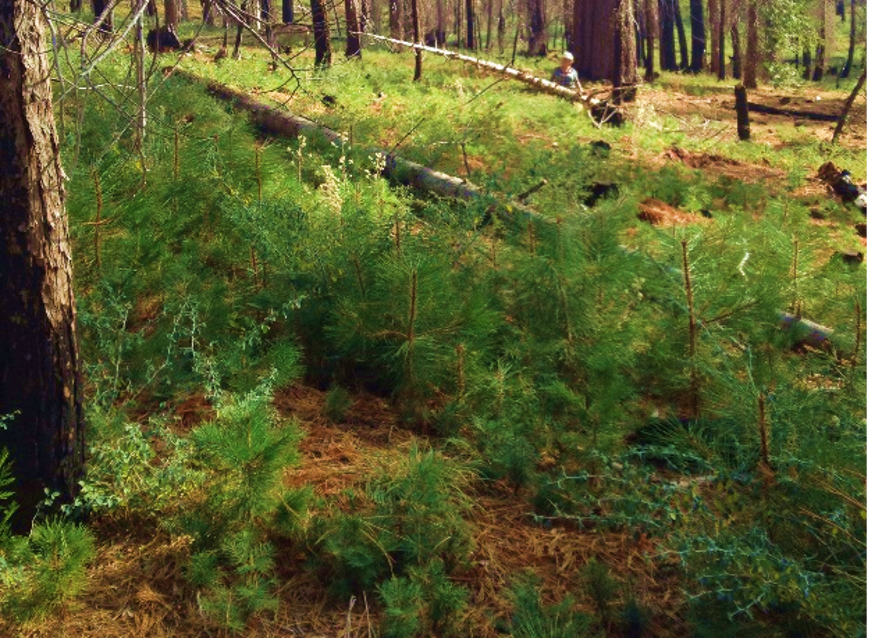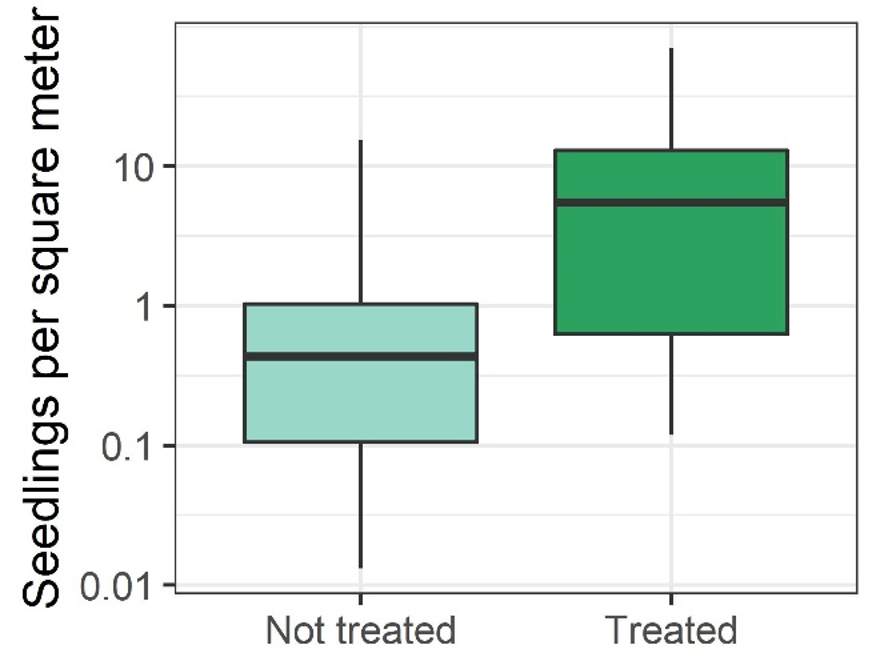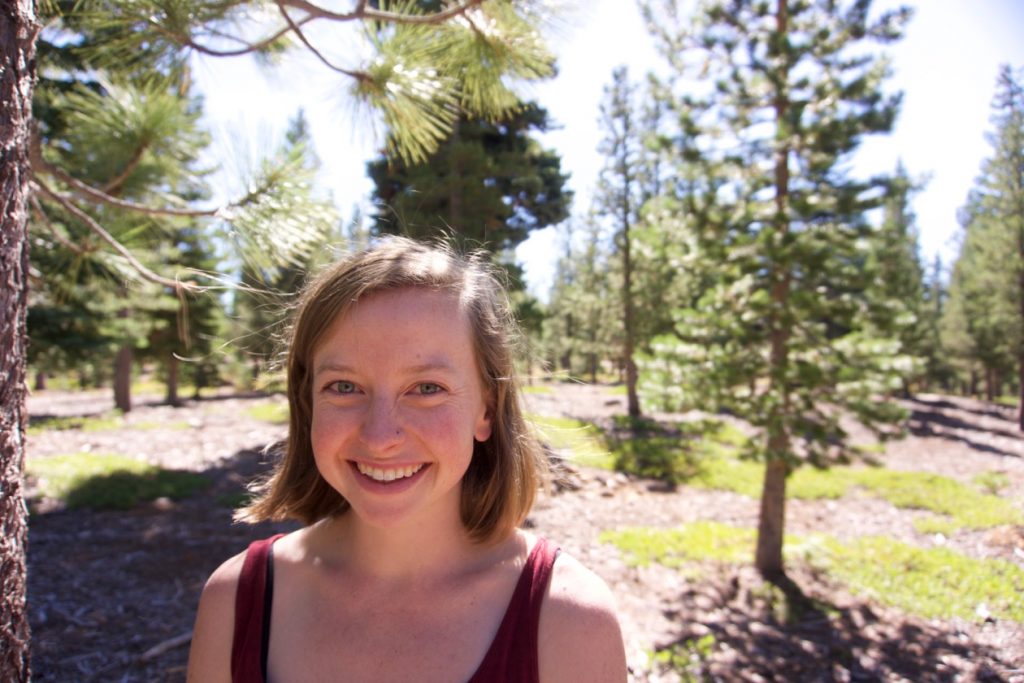
Feel free to contact Carmen at ctubbesing@berkeley.edu or @carmentubbesing if you have questions or comments regarding the content here.
The role of faculty mentor can best be described as a journey where you get to be the back seat driver. You are not responsible for where you go or how you get there but you do get to suggest a route and to criticize the driving! Most people hate backseat drivers but as is so often the case, Carmen is exceptional! She has not one but two backseat drivers on her dissertation committee. Fortunately for all us, Carmen has known her destination and traveled there with unerring navigation.
Carmen started at Berkeley as a hard-core field scientist. For fun, she hiked the length of the Appalachian Trail the summer before starting graduate school. For work, she decided we had to know what was happening to tiny trees trapped beneath dense thickets of post-fire “hard chaparral.” It is called hard chaparral for a reason — you have to crawl and bleed your way through sharp tangles of shrubs to make your measurements.
As if three field seasons spent in Sierran shrubfields was not challenging enough, Carmen decided she also had to master cutting edge data science techniques to fully leverage her valuable field data. So she entered the world of Git Hub, and machine learning algorithms, and MLE models that span six lines long. As you will shortly hear, the intellectual products that resulted from this merger of the field rat and data nerd are truly astonishing.
At some point during this journey, we back seat drivers just shut up. We were on a joy ride where we had a great view of the future of our science. Not that the drive has been all smooth blacktop. Carmen has steered through the sharp turns and detours that life and science have thrown her way. But in the spirit of the thru-hiker, Carmen has pushed on. It has been our privilege and pleasure to have Carmen in our labs and in our lives. Congratulations on a job exceedingly well done.
– John Battles and Scott Stephens,
Professors, Department of ESPM
About Carmen
Carmen is a fire and forest ecologist who studies the causes, consequences, and mitigation of severe disturbances in the Sierra Nevada, including wildfire and tree die-off. Her dissertation focuses on fuel treatment efficacy and how shrub and tree species interact during post-fire recovery. Her research culminated in a data-driven simulation model of forest growth in the decades after severe wildfire. In addition to her dissertation research, she has worked on significant side projects looking into the feasibility of woody biomass electricity using dead wood from drought-induced forest die-off. She holds a BS in biology from Brown University. Starting in June, she will work as a postdoc with her graduate co-advisor John Battles, providing science support for the Science Advisory Panel to California’s Forest Management Task Force.
Dissertation title:
Post-fire tree regeneration in an altered disturbance regime: community dynamics and interactions with land management
I study how modern wildfire patterns affect the ecology of forests. Though fire has shaped ecosystems in California for millennia, modern human forces are reshaping fire regimes, leading to unprecedented forest conditions and unknown long-term consequences. Land management can help mitigate undesired effects of altered fire regimes, but effective management requires information about tree species’ responses to fire both historical and modern. In my dissertation, I add to a body of literature examining how novel fire patterns affect tree regeneration and whether forest management strategies can mitigate any undesired effects.
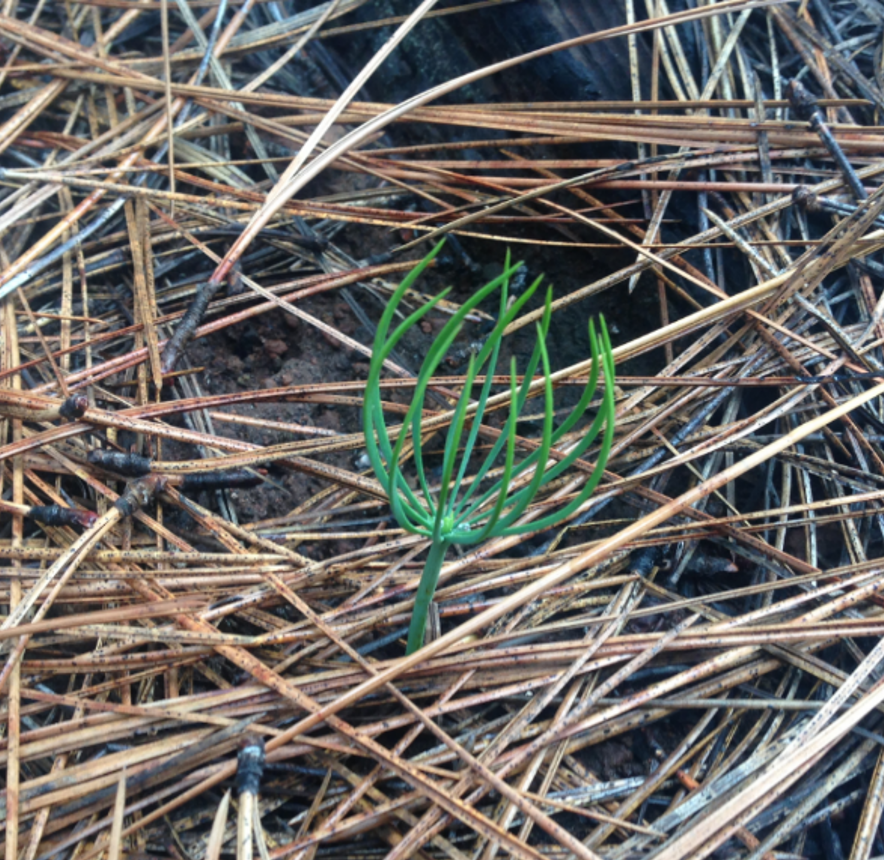
I focus on mixed-conifer forests of the Sierra Nevada, where fire was once frequent, patchy, and heterogeneous, with a mixture of low, moderate, and high severity patches. Now, due to logging, fire exclusion, and climate change, forests increasingly experience either no fire at all or severe fire producing large patches of near-total overstory mortality. The tree species that have long comprised these forests are not well adapted to regenerate in large, homogenous fire patches. My dissertation investigates three main questions in three chapters:
1) Can forest management prevent large fire patches and promote post-fire recovery?
2) Will the novel fire regime shift overall species composition toward firs and away from pines?
3) What is the role of post-fire shrub dynamics in determining forest recovery in novel-type fire patches?
Chapter 1 takes advantage of a natural experiment to test the efficacy of a common land management strategy in promoting fire resistance and recovery. Strategically placed landscape treatments (SPLATs) is a term coined in the early 2000s to describe the practice of actively managing a small fraction of a landscape to achieve landscape-wide fire mitigation. SPLATs can be forest thinning, prescribed fire, or other strategies that reduce fuels. They are placed in portions of the landscape where they are expected to affect downstream fire behavior. Though the SPLATs concept underpins regional public forest plans, it has rarely been tested empirically.
In the late 2000s, a treatment network was implemented in an area termed Last Chance, in the Tahoe National Forest within the northern Sierra Nevada. My advisors and their colleagues monitored this treatment network closely, as part of the Sierra Nevada Adaptive Management Project (SNAMP). Their goal was to test the effects of a real-world treatment network designed to conform with SPLAT principles.
In 2013, SNAMP post-treatment field surveys were abruptly halted by the American Fire, an 11,102-ha wildfire typical of modern mixed-severity fires. The American Fire produced a natural experiment, allowing us to test whether the Last Chance treatments performed as expected in an actual wildfire. In 2015, I returned to SNAMP plots within the American Fire footprint to measure post-fire tree regeneration. I also analyzed the spatial patterns of the American Fire using field data, fire behavior modeling, and a fire severity map derived from remote sensing.
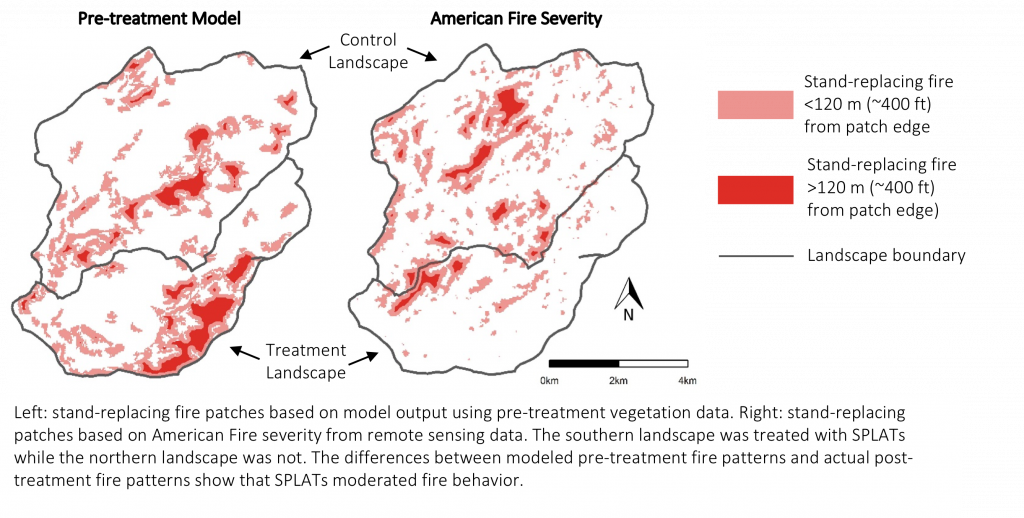
I found that the treated portion of the Last Chance study area experienced lower fire severity and fewer large high-severity fire patches than the adjacent untreated portion. The success of treatments was likely due in part to their placement in the highest-risk areas of the landscape. I also found that treated plots had higher seedling densities than untreated plots, potentially due to the fact that fire moderated neighborhood fire severity, which enhanced tree regeneration. Regeneration was dominated by firs rather than pines. The study was published last year in Forest Ecology and Management. You can also read more about it in a research brief I prepared for the California Fire Science Consortium.
RIGHT: Treated plots in the American Fire footprint had higher seedling densities than untreated plots. Note that the y-axis increases by multiples of ten.
See below a short clip of Carmen talking about the benefits of forest treatments designed to reduce fire risk.
Chapter 2 focuses on differences between firs and pines under the altered fire regime of the Sierra Nevada. It is well known that fire exclusion advantages shade-tolerant trees (e.g. firs) over shade-intolerant trees (e.g. pines). I explore the idea that large stand-replacing fire patches, a result of fire exclusion, may also promote firs. I developed a conceptual framework describing how the novel fire regime promotes two types of fir enrichment, overstory-driven fir enrichment and patch-driven fir enrichment, with the latter caused by differences in dispersal as well as in shrub/tree interactions.
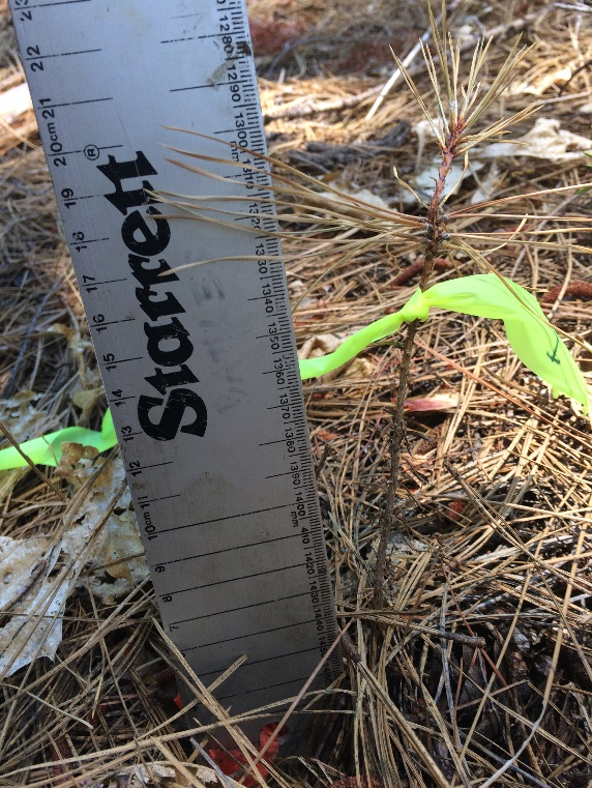
Shrub interactions are particularly important in post-fire recovery because native shrubs quickly reoccupy severely burned areas. I measured fir and pine growth and survival in relation to shrub neighborhood to test whether shrub interactions provide an advantage to firs. I found that ponderosa pine growth is more sensitive to shrub competition following wildfire than fir growth, presumably due to fir’s high shade tolerance.
Though pines are generally considered fire-adapted, this study argues that post-fire species interactions in a novel fire regime may exacerbate the already shifting species composition toward shade-tolerant species, which are less well adapted to survive future fires and to persist in future drier, warmer climates. This study was recently published in the open-access journal Ecosphere.
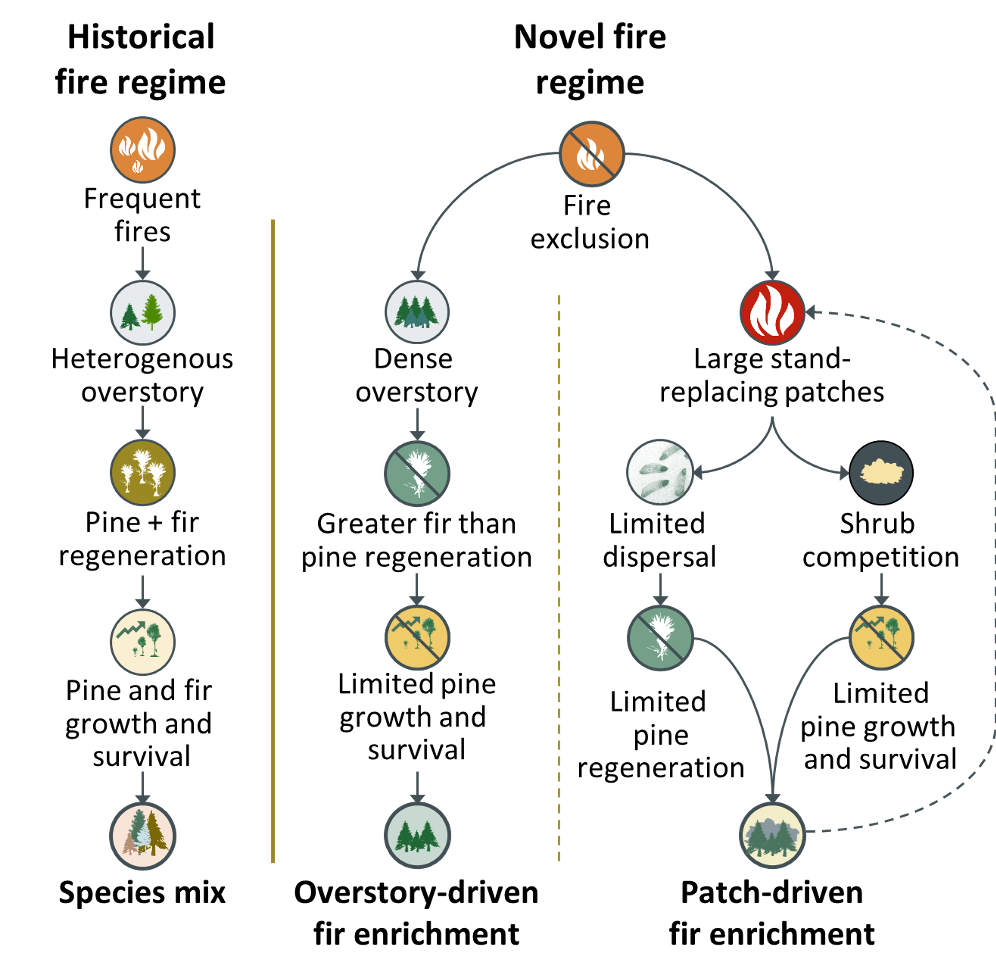
In Chapter 3, I further explore the effect of shrub neighborhood dynamics on fir and pine recovery. The results of Chapter 2 provided initial evidence that post-fire shrub patches may favor firs. However, to test whether the species differences I found have long-term ramifications, it was necessary to model tree growth and survival through time under realistic post-fire conditions. To do this, I developed a data-driven statistical simulation model that builds on the equations found in Chapter 2. Additional information on shrub dynamics was required to parameterize the model, so I synthesized and analyzed data from regional field surveys.
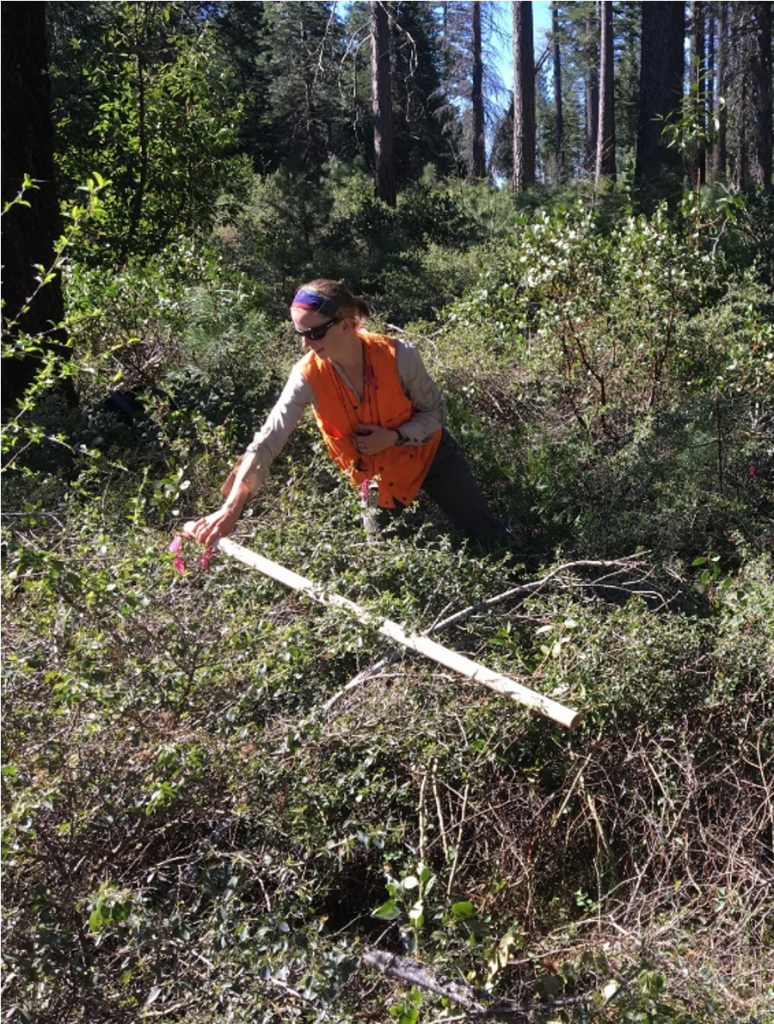
I used my new model to test whether shrubs act as an ecological filter by precluding, delaying, or altering the composition of conifer recovery. I also tested differences in model results for individual shrub species and individual dimensions of shrub neighborhood dynamics.
My model indicated that, contrary to the hypothesis put forth in Chapter 2, shrub competition does not impede pine recovery enough to shift relative success toward firs. In the model, pines grew slower under higher shrub competition, but because of rapid initial growth and low mortality rates they reached the overstory in equal proportions to firs. In fact, pine relative success was higher than fir’s under two of the three focal shrub species: deerbrush and whitethorn ceanothus. However, the final densities of pine were far lower than fir because of large differences in initial seedling densities. Thus, a stronger ecological filter may exist during the establishment phase than the growth and survival phases.
As is common in research, my dissertation opened more questions than it answered. I look forward to further exploring these topics as a post-doc in my advisor John Battles’ lab starting in June. I’m thrilled to stay in the beautiful city of Berkeley and to continue working with John and the rest of the Battles and Stephens labs.
Carmen’s dissertation research has been funded by the following agencies and awards
- Joint Fire Science Program Graduate Innovation Award
- Graduate Training in Cooperative Extension Fellowship
- W. S. Rosencrans Fellowship Award
- NSF Research Traineeship Environment and Society: Data Sciences for the 21st Century (DS421)
- The Garden Club of America Fellowship in Ecological Restoration
- Northern California Botanists Research Scholarship

